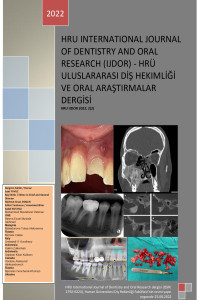Farklı İrrigasyon Protokollerinin Sonik Sistem Aktivasyonuyla Smear Tabakasına Etkisinin Taramalı Elektron Mikroskobunda (SEM) Değerlendirilmesi
Smear tabakası, klorheksidin, sodyum hipoklorit
The Evaluation Of The Effect Of Different Irrigation Protocols With Sonic System Activation On Smear Layer With Scanning Electron Microscope
sodyum hypoclorid, chlorhexidine, sodium hypochlorite,
___
- 1.Plotino G, Colangeli M, Özyürek T, DeDeus G, Panzetta C, Castagnola R, et al. Evaluation of smear layer and debris removal by stepwise intraoperative activation (SIA) of sodium hypochlorite. Clinical Oral Investigations. 2021;25(1):237-45.
- 2.Sabet NE, Lutfy RA. Ultrastructural morphologic evaluation of root canal walls prepared by two rotary nickel-titanium systems: a comparative study. Oral Surgery, Oral Medicine, Oral Pathology, Oral Radiology, and Endodontology. 2008;106(3):e59-e66.
- 3.Schäfer E, Vlassis M. Comparative investigation of two rotary nickel–titanium instruments: ProTaper versus RaCe. Part 1. Shaping ability in simulated curved canals. International endodontic journal. 2004;37(4):229-38.
- 4.Javaheri HH, Javaheri GH. A comparison of three Ni-Ti rotary instruments in apical transportation. Journal of endodontics. 2007;33(3):284-6.
- 5.Mohammadi Z, Shalavi S, Yaripour S, Kinoshita J-I, Manabe A, Kobayashi M, et al. Smear layer removing ability of root canal irrigation solutions: a review. Journal of Contemporary Dental Practice. 2019;20(3):395-402.
- 6.Foschi F, Nucci C, Montebugnoli L, Marchionni S, Breschi L, Malagnino V, et al. SEM evaluation of canal wall dentine following use of Mtwo and ProTaper NiTi rotary instruments. International Endodontic Journal. 2004;37(12):832-9.
- 7.Violich D, Chandler N. The smear layer in endodontics–a review. International endodontic journal. 2010;43(1):2-15.
- 8.Bayırlı G.: Pulpa patolojisi ve tedavileri. İÜ Basımevi ve Film Merkezi, İstanbul. 1991.
- 9.Stock CJ, Gulabivala K, Goodman JR, Walker RT. Color atlas and text of endodontics: Mosby; 1995.
- 10.Çapar İD, Ari Aydinbelge H. Effectiveness of various irrigation activation protocols and the self‐adjusting file system on smear layer and debris removal. Scanning: The Journal of Scanning Microscopies. 2014;36(6):640-7.
- 11.Brito PR, Souza LC, de Oliveira JCM, Alves FR, De-Deus G, Lopes HP, et al. Comparison of the effectiveness of three irrigation techniques in reducing intracanal Enterococcus faecalis populations: an in vitro study. Journal of endodontics. 2009;35(10):1422-7.
- 12.Kuah H-G, Lui J-N, Tseng PS, Chen N-N. The effect of EDTA with and without ultrasonics on removal of the smear layer. Journal of endodontics. 2009;35(3):393-6.
- 13.Hülsmann M, Rümmelin C, Schäfers F. Root canal cleanliness after preparation with different endodontic handpieces and hand instruments: a comparative SEM investigation. Journal of endodontics. 1997;23(5):301-6.
- 14.BYSTRÖM A, SUNDQVIST G. Bacteriologic evaluation of the efficacy of mechanical root canal instrumentation in endodontic therapy. European Journal of Oral Sciences. 1981;89(4):321-8.
- 15.Torabinejad M, Handysides R, Khademi AA, Bakland LK. Clinical implications of the smear layer in endodontics: a review. Oral Surgery, Oral Medicine, Oral Pathology, Oral Radiology, and Endodontology. 2002;94(6):658-66.
- 16.Pérez-Heredia M, Ferrer-Luque C. Gon-34. zález-Rodriguez M.: The Effectiveness of Different Acid Irrigating Solutions in Root Canal Clearing Alter Hand and Rotary Instrumentation. J Endod. 2006;32(10):993-7.
- 17.Mancini M, Armellin E, Casaglia A, Cerroni L, Cianconi L. A comparative study of smear layer removal and erosion in apical intraradicular dentine with three irrigating solutions: a scanning electron microscopy evaluation. Journal of endodontics. 2009;35(6):900-3.
- 18.Serper A, Calt S, Dogan AL, Guc D, Özçgelik B, Kuraner T. Comparison of the cytotoxic effects and smear layer removing capacity of oxidativepotential water, NaOCl and EDTA. Journal of oral science. 2001;43(4):233-8.
- 19.Stamos DE, Sadeghi EM, Haasch GC, Gerstein H. An in vitro comparison study to quantitate the debridement ability of hand, sonic, and ultrasonic instrumentation. Journal of endodontics. 1987;13(9):434-40.
- 20.Orlowski NB, Schimdt TF, da Silveira Teixeira C, Garcia LdFR, Savaris JM, Tay FR, et al. Smear Layer Removal Using Passive Ultrasonic Irrigation and Different Concentrations of Sodium Hypochlorite. Journal of Endodontics. 2020;46(11):1738-44.
- 21.Rödig T, Döllmann S, Konietschke F, Drebenstedt S, Hülsmann M. Effectiveness of different irrigant agitation techniques on debris and smear layer removal in curved root canals: a scanning electron microscopy study. Journal of endodontics. 2010;36(12):1983-7.
- 22.Caron G, Nham K, Bronnec F, Machtou P. Effectiveness of different final irrigant activation protocols on smear layer removal in curved canals. Journal of endodontics. 2010;36(8):1361-6.
- 23.Charlie K, Kuttappa M, George L, Manoj K, Joseph B, John NK. A scanning electron microscope evaluation of smear layer removal and antimicrobial action of mixture of tetracycline, acid and detergent, sodium hypochlorite, ethylenediaminetetraacetic acid, and chlorhexidine gluconate: an in vitro study. Journal of International Society of Preventive & Community Dentistry. 2018;8(1):62.
- Başlangıç: 2021
- Yayıncı: Harran Üniversitesi
Büşra KARAAĞAÇ ESKİBAĞLAR, Buket AYNA
Kübra CERAN DEVECİ, Yasin ÇİÇEK, Abdulsamet TANIK
Süt Dişlerinde Direkt Pulpa Kaufaj Tedavisi
Bibliometric Analysis of Turkish Endodontic Journal
Evaluation of CFR-PEEK Miniplates with Finite Element Analysis in Mandibular Angle Fracture
Mehmet Zahit BAŞ, Enes BEKMAN, Musa ERDEM
Meryem BAYAM KARA, Elif Nur YOLCU, Sadullah KAYA
ERGENLİK ÇAĞINDAKİ ÖĞRENCİLERİN BESLENME İLE DİŞ SAĞLIĞI ARASINDAKİ İLİŞKİNİN İNCELENMESİ
Mehmet Sinan DOĞAN, Zelal ALMAK, Maksut CENGİZ, Sedef KOTANLI
Management Of Oral Ranula With Modified Micro-Marsupialization
Zülfikar KARABIYIK, Mahmut Sami YOLAL, Mohammad Nabi BASİRY
Treatment of Eagle’s Syndrome By Intended Fracture of The Styloid Process: Report of Two Cases
Meriç DEVELİ, Öznur ÖZALP, Alper SİNDEL
LUMBAR DİSK HERNİSİ OPERASYONLARININ ENDOTRAKEAL KAF BASINCINA VE TRAKEAL MORBİDİTEYE ETKİSİ
